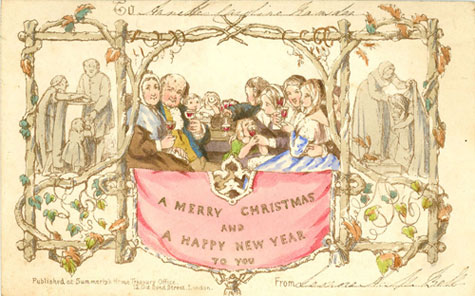ARCHIVAL MOMENT
Auld Lang Syne – Times Gone By
The most commonly sung song for English-speakers on New Year’s Eve, “Auld Lang Syne” is a Scottish song that was first published by the poet Robert Burns in the 1796 edition of the book, Scots Musical Museum. Burns transcribed it (and made some refinements to the lyrics) after he heard it sung by an old man from the Ayrshire area of Scotland.
“Auld Lang Syne” literally translates as “old long since” and means “times gone by.” The song asks whether old friends and times will be forgotten and promises to remember people of the past with fondness, “For auld lang syne , we’ll take a cup o’ kindness yet.”
There’s plenty of documentary evidence establishing “Auld Lang Syne” as a New Year’s Eve favorite since the mid-19th century:
The New Times reported in 1896: “The company joined hands in the great music room at midnight and sang ‘Auld Lang Syne’ as the last stroke of 12 sounded.”
It was a Canadian bandleader Guy Lombardo who popularized the song. Lombardo first heard “Auld Lang Syne” in his hometown of London, Ontario, where it was sung by Scottish immigrants. When he and his brothers formed the dance band, Guy Lombardo and His Royal Canadians, the song became one of their standards. Lombardo played the song at midnight at a New Year’s eve party at the Roosevelt Hotel in New York City in 1929, and a tradition was born.
The song became such a New Year’s tradition that Life magazine wrote “if Lombardo failed to play ‘Auld Lang Syne,’ the American public would not believe that the new year had really arrived.”
There is – as with all things – a Newfoundland connection. The musical Auld Lang Syne was written by Newfoundland born playwright Hugh Abercrombie Anderson. Born in St. John’s , Anderson was the son of the politician John Anderson. In 1921 he became manager of a theatrical business in New York owned by his brother John Murray Anderson. Under the pen name of Hugh Abercrombie he wrote the musical Auld Lang Syne, a musical romance in two acts. It was used as the theme song in the 1940 movie Waterloo Bridge.
 New Year’s Eve Countdown & Fireworks : When the clock strikes midnight tonight, the people of Newfoundland and Labrador are the first in North America to celebrate the New Year.
New Year’s Eve Countdown & Fireworks : When the clock strikes midnight tonight, the people of Newfoundland and Labrador are the first in North America to celebrate the New Year.
Pet owners are reminded that the noise associated with ‘gun fire’ and ‘fireworks’ will likely be a frightening experience for your pet – please attend to your pets, most pets would prefer to be inside during the fireworks display.
 While standing with friends tonight singing Auld Lang Syne pull out this posting and sing along !!
While standing with friends tonight singing Auld Lang Syne pull out this posting and sing along !!
TIMES GONE BY
Should old acquaintances be forgotten,
And never brought to mind?
Should old acquaintances be forgotten,
And days of long ago!
Chorus:
For times gone by, my dear
For times gone by,
We will take a cup of kindness yet
For times gone by.
We two have run about the hillsides
And pulled the daisies fine,
But we have wandered many a weary foot
For times gone by.
We two have paddled (waded) in the stream
From noon until dinner time,
But seas between us broad have roared
Since times gone by.
And there is a hand, my trusty friend,
And give us a hand of yours,
And we will take a goodwill drink (of ale)
For times gone by!
And surely you will pay for your pint,
And surely I will pay for mine!
And we will take a cup of kindness yet
For times gone by!
Happy New Year.
I hope that you are enjoying your “Archival Moments”.






